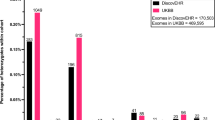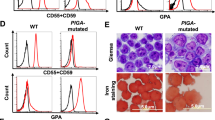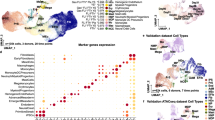Abstract
We utilized a unique culture system to analyze the expression patterns of gene, protein, and cell surface antigen, and the biological process of the related genes in erythroid and myeloid differentiation and switching of hematopoietic stem cells (HSCs) in response to cytokine alterations. Gene-specific fragments (266) identified from five populations of cytokine-stimulated HSCs were categorized into three groups: (1) expressed specifically in a single cell population; (2) expressed in two cell populations, and (3) expressed in three or more populations. Of 145 defined cDNAs, three (2%) were novel genes. Protein two-dimensional gel electrophoresis and flow cytometry analyses showed overlapped and distinguished protein expression profiles in the cell populations studied. Biological process mapping of mRNAs expressed in erythroid and myeloid lineages indicated that mRNAs shared by both lineages attended 'core processes,' whereas genes specifically expressed in either lineage alone were related to specific processes or cellular maturation. Data from this study support the hypothesis that committed HSCs (E14 or G14) cells can still be redirected to develop into myeloid or erythroid cells when erythropoietin (EPO) is replaced with granulocyte-colony stimulating factor (G-CSF) under erythroid-cultured condition or G-CSF with EPO in myeloid-cultured environment, respectively. Our results suggest that genes or proteins co-expressed in erythroid and myeloid lineages may be essential for the lineage maintenance and switching in hematopoiesis.
Similar content being viewed by others
Log in or create a free account to read this content
Gain free access to this article, as well as selected content from this journal and more on nature.com
or
References
Xie H, Ye M, Feng R, Graf T . Stepwise reprogramming of B cells into macrophages. Cell 2004; 117:663–676.
Klinken SP, Alexander WS, Adams JM . Hemopoietic lineage switch: v-raf oncogene converts Emu-myc transgenic B cells into macrophages. Cell 1988; 53:857–867.
Moore BE, Quesenberry PJ . The adult hemopoietic stem cell plasticity debate: idols vs new paradigms. Leukemia 2003; 17:1205–1210.
Wang A, Pierce A, Judson-Kremer K, et al. Rapid analysis of gene expression (RAGE) facilitates universal expression profiling. Nucleic Acids Res 1999; 27:4609–4618.
Greaves MF, Chan LC, Furley AJ, Watt SM, Molgaard HV . Lineage promiscuity in hemopoietic differentiation and leukemia. Blood 1986; 67:1–11.
Ribadeau Dumas A, Hamouda NB, Leriche L, et al. Establishment and characterization of a new human erythroleukemic cell line, ERY-1. Leuk Res 2004; 28:1329–1339.
Schwieger M, Lohler J, Fischer M, Herwig U, Tenen DG, Stocking C . A dominant-negative mutant of C/EBPalpha, associated with acute myeloid leukemias, inhibits differentiation of myeloid and erythroid progenitors of man but not mouse. Blood 2004; 103:2744–2752.
Matsumoto K, Yasui K, Yamashita N, et al. In vitro proliferation potential of AC133 positive cells in peripheral blood. Stem Cells 2000; 18:196–203.
Ruzicka K, Grskovic B, Pavlovic V, Qujeq D, Karimi A, Mueller MM . Differentiation of human umbilical cord blood CD133+ stem cells towards myelo-monocytic lineage. Clin Chim Acta 2004; 343:85–92.
Summers YJ, Heyworth CM, de Wynter EA, Hart CA, Chang J, Testa NG . AC133+ G0 cells from cord blood show a high incidence of long-term culture-initiating cells and a capacity for more than 100 million-fold amplification of colony-forming cells in vitro. Stem Cells 2004; 22:704–715.
Tjonnfjord GE, Steen R, Veiby OP, Egeland T . Lineage commitment of CD34+ human hematopoietic progenitor cells. Exp Hematol 1996; 24:875–882.
van Lochem EG, van der Velden VH, Wind HK, te Marvelde JG, Westerdaal NA, van Dongen JJ . Immunophenotypic differentiation patterns of normal hematopoiesis in human bone marrow: reference patterns for age-related changes and disease-induced shifts. Cytometry B Clin Cytom 2004; 60:1–13.
Scicchitano MS, McFarland DC, Tierney LA, Narayanan PK, Schwartz LW . In vitro expansion of human cord blood CD36+ erythroid progenitors: temporal changes in gene and protein expression. Exp Hematol 2003; 31:760–769.
Terstappen LW, Safford M, Loken MR . Flow cytometric analysis of human bone marrow. III. Neutrophil maturation. Leukemia 1990; 4:657–663.
Ashburner M, Ball CA, Blake JA, et al. Gene ontology: tool for the unification of biology. The Gene Ontology Consortium. Nat Genet 2000; 25:25–29.
Zhong S, Storch KF, Lipan O, Kao MC, Weitz CJ, Wong WH . GoSurfer : a graphical interactive tool for comparative analysis of large gene sets in gene ontology space. Appl Bioinform 2004; 3:261–264.
Storch KF, Lipan O, Leykin I, et al. Extensive and divergent circadian gene expression in liver and heart. Nature 2002; 417:78–83.
May T, Hauser H, Wirth D . Transcriptional control of SV40 T-antigen expression allows a complete reversion of immortalization. Nucleic Acids Res 2004; 32:5529–5538.
Lui WO, Foukakis T, Liden J, et al. Expression profiling reveals a distinct transcription signature in follicular thyroid carcinomas with a PAX8-PPAR(gamma) fusion oncogene. Oncogene 2005; 24:1467–1476.
Wang Z, Neuburg D, Li C, et al. Global gene expression profiling in whole-blood samples from individuals exposed to metal fumes. Environ Health Perspect 2005; 113:233–241.
Chen L, Zhang J, Tang DC, Fibach E, Rodgers GP . Influence of lineage-specific cytokines on commitment and asymmetric cell division of haematopoietic progenitor cells. Br J Haematol 2002; 118:847–857.
Krause DS . Regulation of hematopoietic stem cell fate. Oncogene 2002; 21:3262–3269.
Zinovyeva MV, Zijlmans JM, Fibbe WE, Visser JW, Belyavsky AV . Analysis of gene expression in subpopulations of murine hematopoietic stem and progenitor cells. Exp Hematol 2000; 28:318–334.
Shi Y, Chen L, Liotta LA, Wan HH, Rodgers GP . Glia maturation factor gamma (GMFG): a cytokine-responsive protein during hematopoietic lineage development and its functional genomics analysis. Genomics Proteomics Bioinform 2006; In press.
Sato T, Laver JH, Ogawa M . Reversible expression of CD34 by murine hematopoietic stem cells. Blood 1999; 94:2548–2554.
Inagaki M, Aoyama M, Sobue K, et al. Sensitive immunoassays for human and rat GMFB and GMFG, tissue distribution and age-related changes. Biochim Biophys Acta 2004; 1670:208–216.
Kawai Y, Asai K, Miura Y, et al. Structure and promoter activity of the human glia maturation factor-gamma gene: a TATA-less, GC-rich and bidirectional promotor. Biochim Biophys Acta 2003; 1625:246–252.
Reya T, Morrison SJ, Clarke MF, Weissman IL . Stem cells, cancer, and cancer stem cells. Nature 2001; 414:105–111.
Momose H, Kurosu H, Tsujimoto N, et al. Dual phosphorylation of phosphoinositide 3-kinase adaptor Grb2-associated binder 2 is responsible for superoxide formation synergistically stimulated by Fc gamma and formyl-methionyl-leucyl-phenylalanine receptors in differentiated THP-1 cells. J Immunol 2003; 171:4227–4234.
Golay J, Introna M, Graf T . A single point mutation in the v-ets oncogene affects both erythroid and myelomonocytic cell differentiation. Cell 1988; 55:1147–1158.
Robb L, Lyons I, Li R, et al. Absence of yolk sac hematopoiesis from mice with a targeted disruption of the scl gene. Proc Natl Acad Sci USA 1995; 92:7075–7079.
Shalaby F, Ho J, Stanford WL, et al. A requirement for Flk1 in primitive and definitive hematopoiesis and vasculogenesis. Cell 1997; 89:981–990.
Toren A, Bielorai B, Jacob-Hirsch J, et al. CD133-positive hematopoietic stem cell “stemness” genes contain many genes mutated or abnormally expressed in leukemia. Stem Cells 2005; 23:1142–1153.
Jaatinen T, Hemmoranta H, Hautaniemi S, et al. Global gene expression profile of human cord blood-derived CD133+ cells. Stem Cells 2006; 24:631–641.
Kondo M, Scherer DC, Miyamoto T, et al. Cell-fate conversion of lymphoid-committed progenitors by instructive actions of cytokines. Nature 2000; 407:383–386.
Haughn L, Hawley RG, Morrison DK, von Boehmer, Hockenbery DM . BCL-2 and BCL-XL restrict lineage choice during hematopoietic differentiation. J Biol Chem 2003; 278:25158–25165.
Zhao S, Weinreich MA, Ihara K, Richard RE, Blau CA . In vivo selection of genetically modified erythroid cells using a jak2-based cell growth switch. Mol Ther 2004; 10:456–468.
Mayani H, Dragowska W, Lansdorp PM . Lineage commitment in human hemopoiesis involves asymmetric cell division of multipotent progenitors and does not appear to be influenced by cytokines. J Cell Physiol 1993; 157:579–586.
Akashi K . Lineage promiscuity and plasticity in hematopoietic development. Ann N Y Acad Sci 2005; 1044:125–131.
Roeder I, Glauche I . Towards an understanding of lineage specification in hematopoietic stem cells: a mathematical model for the interaction of transcription factors GATA-1 and PU.1. J Theor Biol 2006; 241:852–865.
Suh HC, Goova J, Renn K, Friedman AD, Johnson PF, Keller JR . C/EBPα determines hematopoietic cell fate in multipotential progenitor cells by inhibiting erythroid differentiation and inducing myeloid differentiation. Blood 2006; 107:4308–4316.
Acknowledgements
We thank Drs Jim Mei (Lifenhancer Inc.) and Honghui Wan (NIEHS) for valuable assistance with gene sequencing analysis, Dr Sheng Zhong (DBIGB, University of Illinois) for valuable discussion and help with GoSurfer, Dr David Chee (MCHB, NIH) for assistance with gene data analyses, and Drs Peggy Hsieh and R Daniel Camerini-Otero of NIDDK for assistance with 2-DE analyses.
Author information
Authors and Affiliations
Corresponding author
Rights and permissions
About this article
Cite this article
Chen, L., Zhang, H., Shi, Y. et al. Identification of key genes responsible for cytokine-induced erythroid and myeloid differentiation and switching of hematopoietic stem cells by RAGE. Cell Res 16, 923–939 (2006). https://doi.org/10.1038/sj.cr.7310115
Received:
Revised:
Accepted:
Published:
Issue date:
DOI: https://doi.org/10.1038/sj.cr.7310115



